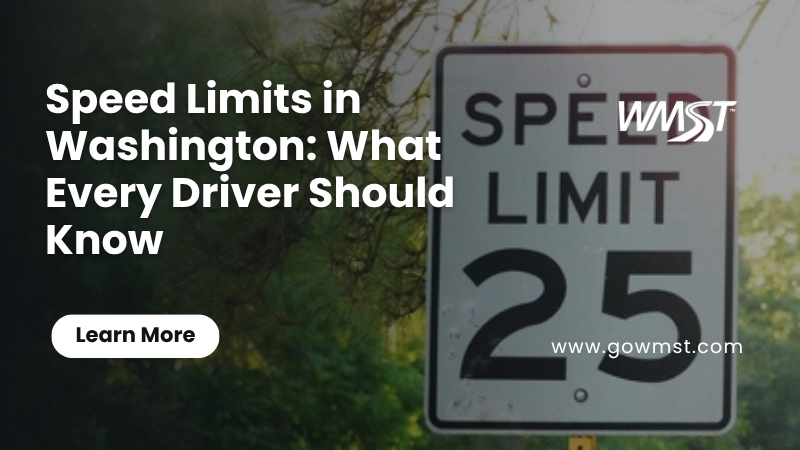Why Speed Limits Matter for Safety and Testing?
Speed limits aren’t just legal boundaries; they’re designed for driver and pedestrian safety. In Washington State, adhering to posted speed limits helps reduce the severity and likelihood of crashes, particularly in residential and school zones.
For new drivers, respecting speed laws is more than just following signs it’s also essential for passing the 技能試験. Examiners watch closely for:
- Maintaining proper speed
- Adjusting to posted signs
- Reducing speed for conditions (hills, turns, weather, congestion)
- Not exceeding limits
Failing to follow speed laws during the test can result in disqualification.
Standard Speed Limits by Area Type (Residential, School Zones, Highways)
Understanding the standard speed zones in Washington helps drivers anticipate changes, even when signage isn’t present.
Posted Limit is the Max Speed Allowed
- In Washington, exceeding the posted limit by even 1 MPH is a violation.
- The posted speed limit is the maximum speed allow in ideal conditions.
- Driving the speed limit in less than ideal conditions can result in a violation.
Residential Speed Limit WA
- の default speed limit in residential areas is 25 mph unless otherwise posted.
- Watch for pedestrians, pets, and parked cars.
- Many new drivers assume 25 mph is safe, but it’s not always legal in Washington. You should lower your speed based on conditions, such as when the street is narrow, visibility is limited or there are pedestrians present.
School Zones
- Typically 20 mph when children are present or when lights are flashing.
- Fines for speeding in school zones are doubled and can’t be reduced by the court.
Urban Streets and Arterials
- Varies between 25–35 mph depending on location and traffic flow.
County Roads
- 50 mph unless otherwise posted
Highway & Freeways Speed Limit WA
- 60 mph unless otherwise posted
- 70 mph in certain rural areas
Drivers are expected to adjust for traffic conditions, weather, and construction zones regardless of the posted maximum.
Common Mistakes New Drivers Make with Speed Limits
Assuming a Speed Limit
Not all roads are marked. New drivers sometimes assume limits based on past experience rather than current conditions. When in doubt, follow default limits for the area type.
Not Adjusting to Conditions
Washington’s weather and road conditions change rapidly. Driving at the posted limit during rain, fog, or icy conditions could still be considered unsafe driving.
Failing to Reduce Speed in School or Construction Zones
Even temporary zones require full compliance. Missing a flashing light or sign could result in steep fines or Skills Test failure.
Driving Too Slowly
Yes, going too slow can also result in test penalties. Driving significantly below the speed limit without reason may indicate poor control, nervousness, or unawareness—all red flags during a test.
How Speed Limits Are Enforced in Washington
Speed enforcement is strict, especially in school zones, construction zones, and residential areas.
Automated Enforcement
Many cities in Washington use automated speed cameras in school zones and red-light intersections. These systems issue tickets based on photographic evidence.
Police Radar Monitoring
Officers use radar and lidar to catch speeding vehicles on highways and busy streets. Enforcement often increases during high-risk times like back-to-school weeks or holidays.
Consequences of Speeding Violations in Washington:
- Fines
- Insurance premium increases
- Traffic school for ticket deferral
- Potential retesting or license suspension for serious infractions or repeat offenses
Speed Awareness Tips for Driving Students
1. Practice with a Speed-Conscious Instructor
Programs like WMST emphasize legal speed awareness during all lessons. Instructors guide students in adjusting speed for hills, intersections, and lane merges.
2. Scan for Speed Limit Signs
Make it a habit to look for signs at the start of every new street or highway entrance. If you don’t see one, refer to the default limits for that zone type.
3. Adjust Early
Don’t wait until the last second to reduce speed. If you see a school zone ahead, begin slowing down gradually to avoid abrupt braking or overshooting.
4. Be Aware of Speed Traps
While this isn’t part of your Skills Test, being aware of frequent speed enforcement areas builds overall awareness and safer habits.
5. Use Cruise Control Sparingly
Cruise control can be useful on highways but avoid using it in areas where speed changes frequently, such as city streets or hills.
Frequently Asked Questions (FAQs)
What is the speed limit in residential areas in Washington?
The default speed limit is 25 mph, unless posted otherwise. This is especially critical in neighborhoods, near parks, and school zones.
Are there different speed limits in school zones?
Yes. Most school zones require 20 mph when children are present or when lights are flashing. These zones are strictly enforced.
Can speed limit violations affect my Skills Test?
Absolutely. Driving over—or significantly under—the speed limit can result in test failure. It’s essential to maintain control and legal speed throughout.
What happens if I drive too slowly during the test?
Driving too slowly without a valid reason (e.g., icy roads) may be interpreted as lack of confidence or poor judgment. Examiners evaluate overall awareness and flow control.
How does WMST help students understand WA speed laws?
WMST integrates Washington speed law education into both classroom instruction and behind-the-wheel lessons. Students are trained to recognize speed zones, adjust for conditions, and drive safely in all areas.
Visit: Top 7 Defensive Driving Habits Every New Driver Should Learn
Conclusion: Know Your Limits And Stick to Them
Speed awareness is one of the most important components of safe driving in Washington. For new drivers, mastering the rules around speed limits in Washington is essential—not only for safety, but also for Skills Test success.
WMST provides expert instruction that helps students:
- Understand default speed limits
- Recognize posted and school zone variations
- Adjust for conditions and safety
- Prepare for real-world driving and the Skills Test with confidence
To learn more about WMST’s curriculum or to enroll in a certified driving course, visit WMST.

